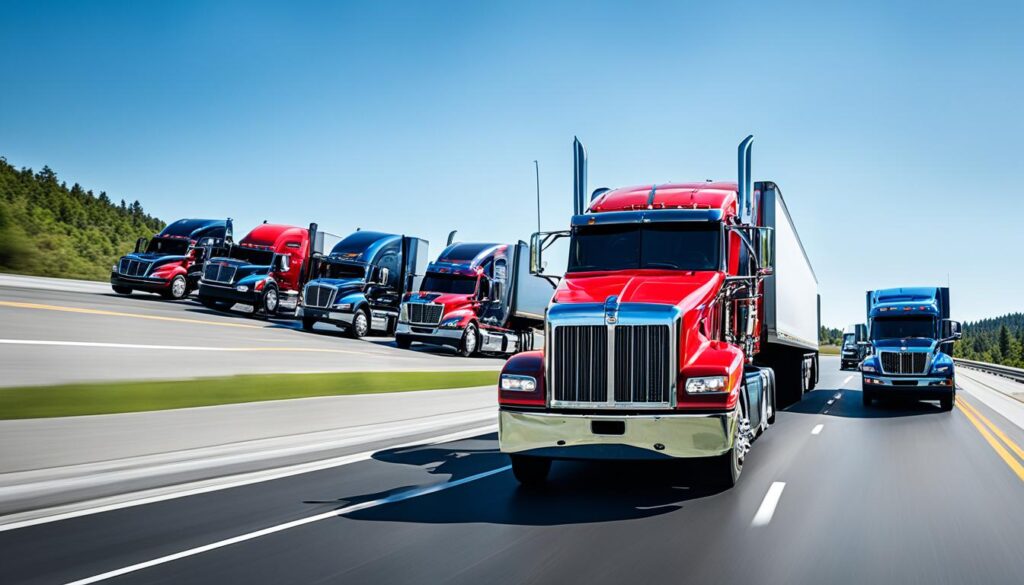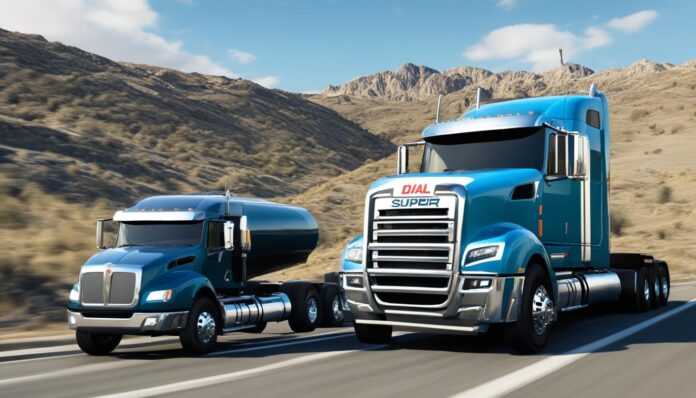As an Amazon Associate, I earn from qualifying purchases
When it comes to choosing the right tires for your vehicle, there are several factors to consider. One important decision is whether to go for super single tires or duals. Both options have their advantages and disadvantages, so it’s essential to understand the key differences between them before making a choice.
Super single tires are heavy-duty, large tires that can replace the typical dual-tire setup. They have been widely used in various industries, including farming, construction, trucking, and off-roading. In this article, we will explore the pros and cons of super single tires compared to duals, helping you make an informed decision.
Key Takeaways:
- Super single tires offer lighter weight and higher load capacity.
- They are better for off-roading due to the elimination of the rock jamming risk between dual tires.
- Super singles have fewer issues with tire pressure monitoring systems and can potentially improve fuel economy.
- On the downside, they lack a built-in backup tire and may require modifications for installation.
- The decision to switch to super single tires depends on your specific needs and preferences.
Advantages of Super Single Tires
Super single tires provide numerous benefits over traditional duals, making them an attractive option for various vehicles and industries.
One significant advantage of super single tires is their lighter weight, which contributes to a lower overall vehicle weight. The reduced weight can lead to improved performance, including enhanced acceleration and handling. Additionally, lighter vehicles may experience less wear on suspension components and brakes, potentially reducing maintenance costs over time.
Another advantage of super single tires is their higher weight rating and load capacity. These tires are designed to carry heavier loads, making them suitable for applications where heavy cargo or equipment needs to be transported efficiently and safely. The increased weight rating allows for greater flexibility in load distribution and handling, ensuring optimal performance in demanding situations.
Super singles excel in off-road environments due to their unique design. By removing the second tire, there is no longer a gap for rocks, debris, or mud to become lodged between dual tires. This reduces the risk of traction loss and minimizes potential damage, making super single tires ideal for off-road vehicles in construction, agriculture, and other rugged settings.
Tire pressure monitoring systems (TPMS) are crucial for vehicle safety, and super single tires often present fewer issues in this regard. With only one tire to monitor, ensuring optimal tire pressure and avoiding underinflation or overinflation becomes a simpler task. This advantage can save time and maintenance costs, while also promoting safer driving conditions.
In addition to these advantages, super single tires have the potential for better fuel economy compared to duals. The reduced weight and lower rolling resistance of super singles can contribute to improved fuel efficiency, resulting in potential cost savings over the long term. This benefit is particularly relevant for industries where fuel expenses make up a significant portion of overall operating costs.
- Lighter weight for improved vehicle performance
- High weight rating and load capacity for carrying heavier loads
- Elimination of the risk of rocks getting jammed between tires for enhanced off-road capabilities
- Fewer issues with tire pressure monitoring systems for easier maintenance
- Potential for better fuel economy, offering long-term cost savings
Disadvantages of Super Single Tires
While super single tires offer numerous advantages, they also come with a set of disadvantages that should be considered before making a decision. Understanding the drawbacks can help you assess whether super singles are the right choice for your specific needs.
Lack of Built-in Backup
One major disadvantage of super single tires is the absence of a built-in backup in case of a flat or blowout. Unlike dual tires, which allow you to continue driving even if one tire fails, super singles leave you vulnerable to potential downtime and inconvenience during tire repair or replacement.
“Super singles don’t have a built-in safety net, so you need to be prepared for the possibility of a tire failure and have a contingency plan in place.”
Availability of Replacements
In the event of tire damage, finding replacements for super single tires may be more challenging than for dual tires. The availability of replacement super singles can vary depending on factors such as location, brand, and specific tire size. This limited availability could potentially lead to extended downtime while waiting for a replacement.
Necessary Modifications
Switching from dual tires to super singles requires certain modifications to accommodate the new tire setup. This includes obtaining new wheels and rims designed for super single tires, as well as making wheel well modifications or suspension lifts. These modifications can add to the overall cost and complexity of the tire replacement process.
Additionally, the increased size and weight of super single tires make them more difficult to lift and maneuver compared to dual tires. This can pose challenges during tire maintenance or in emergency situations where tire changes are required.
Higher Cost
Another disadvantage of super single tires is their higher cost compared to dual tires. The initial investment in super singles and the necessary modifications can be significant. However, it is important to consider the potential long-term benefits and cost savings, such as improved fuel economy, before ruling out super singles solely based on their higher price point.

Summary of Disadvantages:
| Disadvantages of Super Single Tires |
|---|
| Lack of built-in backup |
| Availability of replacements |
| Necessary modifications |
| Higher cost |
Why Would You Want to Switch to Super Single Tires?
The decision to switch to super single tires offers several reasons that may benefit RVers, especially those who engage in off-roading and boondocking. Super single tires provide enhanced performance in rugged terrains and challenging conditions, making them a favorable choice for adventurous travelers. While traditional dual tires perform well on highways, super singles offer distinct advantages that align with the unique needs of RVers.
Benefits of Super Single Tires for RVers
- Improved Off-Roading Capability: Super single tires have a larger contact patch, offering better traction and grip on uneven surfaces. This allows RVers to confidently navigate through dirt roads, rocky terrains, and other off-road adventures without the worry of getting stuck or damaging tires.
- Enhanced Maneuverability: The reduced weight and single tire configuration of super singles contribute to improved maneuverability. RVers can experience smoother turns, easier handling, and increased stability, providing a more enjoyable driving experience.
- Increased Payload Capacity: Super single tires have a higher weight rating and load capacity compared to dual tires. This allows RVers to carry heavier loads, whether it be additional equipment, water tanks, or personal belongings, without compromising the safety and longevity of their tires.
- Better Fuel Efficiency: A lighter overall vehicle weight, thanks to super single tires’ single tire configuration, can lead to potential fuel savings. RVers can enjoy longer trips and maximize their fuel budget while contributing to a more eco-friendly travel experience.
In addition to the benefits mentioned above, super single tires also have the potential to reduce maintenance and tire pressure monitoring system issues compared to dual tires. However, before making the switch, it’s important to consider the cost implications and potential challenges associated with limited availability of replacements.
Ultimately, the decision to switch to super single tires depends on the specific needs, preferences, and travel habits of RVers. While super singles offer compelling benefits for off-road enthusiasts, it’s important to weigh these advantages against the limitations and determine if they align with your RVing lifestyle.

| Advantages of Super Single Tires for RVers | Disadvantages of Super Single Tires for RVers |
|---|---|
| Improved off-roading capability | Lack of a built-in backup tire |
| Enhanced maneuverability | Potential challenges with tire replacements |
| Increased payload capacity | Necessary modifications and associated costs |
| Better fuel efficiency | Potential difficulty in finding replacements |
Conclusion
In conclusion, when it comes to choosing between super single tires and duals, it’s essential to consider the specific needs, driving conditions, and personal preferences. Super singles offer a range of advantages, including weight reduction, higher weight ratings, and potentially better fuel economy. These tires are particularly beneficial for off-roading enthusiasts and those looking to carry heavier loads.
However, it’s important to acknowledge the drawbacks of super single tires. One notable disadvantage is the lack of a built-in backup tire, which can be a concern in the event of a flat or blowout. Additionally, the need for modifications, such as new wheels and rims, as well as potential challenges with availability, should be taken into account.
Ultimately, making the best tire choice comes down to carefully weighing the pros and cons. Super singles offer unique advantages, but they also have their limitations. By thoroughly evaluating your intended use and considering factors such as driving conditions and personal preferences, you can make an informed decision whether to opt for super single tires or stick with traditional duals.
FAQ
What are the differences between super single tires and duals?
Super single tires are large, heavy-duty tires that can replace the typical dual-tire setup. They are lighter, have a higher weight rating and load capacity, and are better for off-roading. Duals, on the other hand, offer a backup tire in case of a flat or blowout.
What are the advantages of super single tires?
Super single tires offer several advantages, including lower vehicle weight, higher weight rating and load capacity, better off-road performance, fewer issues with tire pressure monitoring systems, and potential for better fuel economy.
What are the disadvantages of super single tires?
Super single tires have some drawbacks, such as the lack of a built-in backup tire, potential difficulties in finding replacements, the need for modifications like new wheels and rims, and the higher cost compared to dual tires.
Why would someone want to switch to super single tires?
The decision to switch to super single tires depends on specific needs and preferences. RVers who engage in off-roading and boondocking may find the benefits of super single tires most valuable as they provide better performance in these conditions.
How do I choose between super singles and duals?
The choice between super single tires and duals depends on factors such as the intended use, driving conditions, and personal preferences. Super singles offer advantages such as weight reduction, higher weight ratings, and potential fuel economy benefits, but they also have drawbacks like the lack of a backup tire and the need for modifications.
